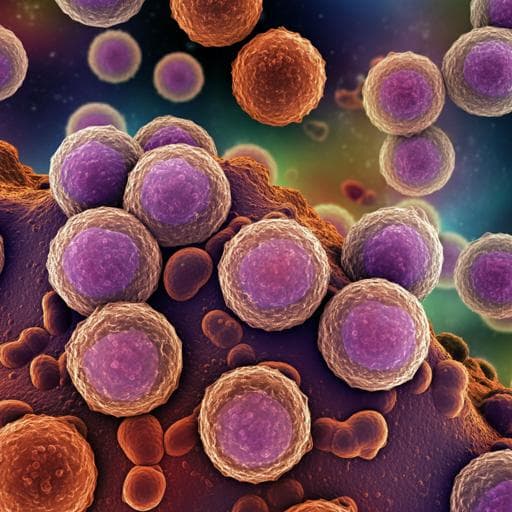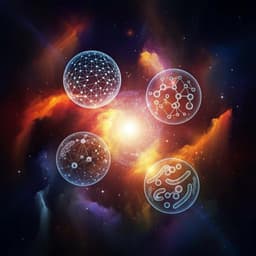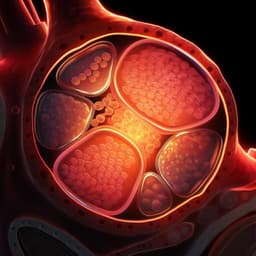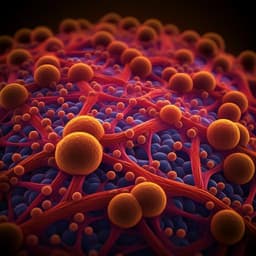
Medicine and Health
Simulated lunar microgravity transiently arrests growth and induces osteocyte-chondrocyte lineage differentiation in human Wharton's jelly stem cells
A. Subramanian, C. H. L. Ip, et al.
This groundbreaking research explores the impact of simulated lunar microgravity on human Wharton's jelly stem cells (hWJSCs). Conducted by an expert team of researchers, the study uncovers how exposure to microgravity induces reversible changes in cell growth and differentiation towards osteocyte-chondrocyte lineages, providing exciting insights for future biotechnological applications.
~3 min • Beginner • English
Introduction
Wharton’s jelly is a mucoid connective tissue of the umbilical cord rich in mesenchymal stem cells (MSCs), collagens, and proteoglycans, providing structural support to prevent vessel occlusion during fetal growth. Human Wharton’s jelly stem cells (hWJSCs) exhibit typical MSC features (adherence, CD73/CD90/CD105 expression) and can differentiate into osteocytes, adipocytes, and chondrocytes in vitro. They express embryonic stem cell markers (POU5F1, NANOG, SOX2, CKIT, DNMT3B) and have immunomodulatory properties relevant to wound healing and tissue regeneration. While many studies have defined chemical and environmental cues that direct hWJSC differentiation into endodermal, mesodermal, and ectodermal lineages, fewer have examined the impact of simulated microgravity on hWJSC growth and lineage commitment. Prior microgravity studies suggested reduced growth and altered expression of stemness and cell cycle markers over short exposures. The present study tested the hypothesis that acute simulated lunar microgravity (sµG; 0.16 G for 72 h) induces changes in hWJSC growth and lineage differentiation detectable at transcriptional and phenotypic levels, and assessed whether these changes persist after return to terrestrial gravity (1.0 G). The purpose was to correlate growth, cell marker expression, viability, and bulk RNA transcriptional changes across multiple primary hWJSC lines, and then determine the maintenance or reversibility of these changes after gravity re-loading.
Literature Review
Multiple protocols have induced hWJSC differentiation into diverse lineages: neuronal (using bFGF, butylated hydroxyanisole, DMSO) with rapid marker acquisition and morphological changes; myogenic, osteogenic, and adipogenic capacities shown histologically after 7–14 days in lineage-specific media; hepatocyte-like differentiation with growth factor cocktails. Environmental factors such as altered oxygen tension, shear stress, and low-serum conditions modulate differentiation and growth. In contrast, reports on simulated microgravity (sµG) in hWJSCs are fewer. Prior studies noted reductions in NANOG and SOX2 after brief sµG exposure, downregulation of cell cycle proteins with reduced growth by ~72 h, and decreased growth in related fibroblast models with increased MSC marker expression. Overall, these findings suggest rapid, transcriptionally detectable lineage changes following sµG, motivating comprehensive multi-omic and phenotypic assessment in hWJSCs and evaluation of post-sµG persistence.
Methodology
Design: Seven primary hWJSC lines (n=7 biological replicates), each cultured in triplicate and pooled for analyses, were exposed to simulated lunar microgravity (sµG; 0.16 G) for 72 h using a Random Positioning Machine (RPM) placed in a CO2 incubator. Controls included a standard 1.0 G control (vented caps with gas exchange) and an experimental control (fully filled, sealed flasks without gas exchange to control for RPM-related conditions). After 72 h, cells were re-seeded under normal gravity for an additional 72 h to assess post-sµG effects.
Cell isolation and culture: hWJSCs were derived from human umbilical cords under IRB approval (Singapore MOH DSRB) using enzymatic digestion (collagenase I/IV, hyaluronidase), followed by culture in high-glucose DMEM with 20% FBS, supplements, ITS, antibiotic-antimycotic, and bFGF.
Simulated lunar microgravity: Cells (5.0×10^4 per T25 flask) were seeded. Control flasks (vented caps) were incubated stationary for 3 days. Experimental control and sµG flasks were completely filled to eliminate bubbles, sealed, and incubated for 3 days; sµG flasks were mounted on the RPM with a preprogrammed 0.16 G profile. Post-sµG, all arms were re-seeded at 5×10^5 cells/flask under 1.0 G for 3 days.
Assessments: Morphology captured by phase-contrast microscopy. Viable cell counts by Trypan Blue staining, both manual (hemocytometer) and automated (Luna Counter). MSC marker expression by FACS (CD34, CD45, CD73, CD90, CD105) using primary antibodies and Alexa Fluor 488 secondary; apoptosis by Annexin V-FITC with PI counterstain. RNA-seq: Total RNA (RIN≥9.0) extracted (RNeasy), libraries prepared (3' directional, polyA enrichment), sequenced 150-bp paired-end on NovaSeq 6000 (~30M reads/sample). Data processing via nf-core/rnaseq v3.10.1 (Trim Galore!, STAR alignment to hg38, Salmon quantification); QC with PCA. Differential expression with DESeq2 adjusting for cell line; significant DEGs defined as ≥2-fold change, FDR<0.05. Visualization with EnhancedVolcano and ComplexHeatmap. Pathway enrichment (GSEA) using clusterProfiler with KEGG; pathways significant at FDR<0.10.
Confirmatory lineage studies: Osteogenic and chondrogenic differentiation induced for 14 days in lineage-specific media (osteogenic: 5% FBS, ascorbic acid, dexamethasone, β-glycerophosphate; chondrogenic: ITS, ascorbic acid, dexamethasone, sodium pyruvate, proline, TGF-β3 10 ng/ml). Histology: von Kossa (osteogenic) and Alcian Blue (chondrogenic) staining with manual counts (n=6 wells/exposure). qRT-PCR for osteogenic (BSP, ALP, OCN) and chondrogenic (COMP, FMOD, COL2A1) markers. Statistics: One-way ANOVA; p<0.05 significant.
Key Findings
- Cell growth and viability: After 72 h sµG, viable cell numbers were significantly decreased versus control and experimental control (manual and automated counts). After 72 h re-loading at 1.0 G, cell numbers increased relative to sµG. Morphology remained fibroblast-like without overt changes across conditions.
- Stemness markers by FACS (Day 3): sµG reduced MSC markers compared to controls: CD73 68.38±10.15%, CD90 70.25±10.39%, CD105 48.21±25.05% vs control CD73 94.46±2.32%, CD90 96.02±1.32%, CD105 91.46±4.02%; experimental control CD73 90.24±4.12%, CD90 91.42±4.20%, CD105 92.00±2.00%. CD34/CD45 remained low across groups. Post-sµG (Day 6), CD marker profiles were restored to levels similar to controls.
- Apoptosis: Annexin V-FITC positivity was low in controls (0.19%) and increased modestly in sµG (2.0%).
- RNA-seq (sµG vs experimental control, Day 3): 636 DEGs (≥2-fold, FDR<0.05): 308 up, 328 down. MKI67 downregulated (fold change -2.40; FDR=1.43×10^-5). Anti-apoptotic BCL2 and BIRC3 downregulated; BAX, BCL2L10, BAK1 not significantly changed. Cell fate regulators DNMT1 and EZH2 downregulated; pluripotency genes POU5F1 and NANOG not significantly changed. Osteo-chondrogenesis-associated genes upregulated: SERPINI1, MSX2, TFPI2, BMP6, COMP, TMEM119, LUM, HGF, CHI3L1, SPP1. qPCR confirmed 5/10 targets.
- RNA-seq (post-sµG vs experimental control, Day 6): 398 DEGs: 180 up, 218 down. Proliferation/cell cycle (MKI67, CDKN1A) and apoptosis-related genes showed no significant differences. Pluripotency (NANOG, POU5F1) and cell fate (DNMT1, EZH2) not significantly changed. BMP6, COMP, CHI3L1 remained upregulated; TMEM119 became significantly downregulated versus its prior upregulation in sµG. qPCR confirmed 6/10 targets.
- GSEA: sµG showed 63 positively enriched KEGG pathways (e.g., oxidative phosphorylation, steroid hormone biosynthesis, sphingolipid metabolism, N-glycan biosynthesis, glycosaminoglycan biosynthesis—heparan/chondroitin sulfate, glycerophospholipid metabolism) and 25 negatively enriched pathways (spliceosome, DNA replication, cell cycle, nucleocytoplasmic transport). Post-sµG showed 98 positively enriched pathways (including oxidative phosphorylation, sphingolipid metabolism, chondroitin sulfate biosynthesis, HIF-1 signaling) and 7 negatively enriched pathways.
- Lineage differentiation assays: After 14 days in osteogenic medium, von Kossa-positive cells (mean±SD, n=6 wells) were 17.8±2.3 (control), 7.7±1.2 (experimental control), 38.7±3.3 (sµG) with sµG significantly higher vs both controls (p<0.001). In chondrogenic medium, Alcian Blue-positive cells were 27.2±5.9 (control), 31.7±3.3 (experimental control), 54.3±7.7 (sµG); sµG significantly higher (p<0.001). qRT-PCR showed osteogenic markers (BSP, ALP, OCN) significantly elevated in sµG (3.12-fold vs control; 6.63-fold vs experimental control) and chondrogenic markers (COMP, FMOD, COL2A1) elevated (2.27-fold vs control; 9.16-fold vs experimental control).
- Reversibility: Growth rate and MSC CD marker expression recovered to near-baseline after 72 h at 1.0 G, whereas a subset of osteo-chondrogenic transcriptional changes persisted.
Discussion
The study addressed whether acute simulated lunar microgravity (0.16 G for 72 h) alters hWJSC growth and lineage fate and whether changes persist after re-exposure to 1.0 G. sµG transiently reduced proliferation (lower viable cell counts, MKI67 downregulation) without major viability loss, and decreased MSC stemness markers (CD73/CD90/CD105), indicating a transient loss of stemness under sµG. These growth and stemness effects were reversible upon 1.0 G re-loading, with CD marker expression and cell counts recovering toward control levels. At the transcriptional level, sµG induced a shift toward osteo-chondrogenic lineage programs, with upregulation of BMP6, MSX2, COMP, CHI3L1, SPP1, and related ECM remodeling genes, while downregulating cell fate regulators DNMT1 and EZH2. GSEA supported enrichment of pathways associated with osteogenic and chondrogenic differentiation, including oxidative phosphorylation and glycosaminoglycan biosynthesis. Functionally, sµG pre-exposure enhanced subsequent osteogenic and chondrogenic differentiation in lineage-specific media, as shown by increased von Kossa and Alcian Blue staining and elevated lineage marker transcripts. Post-sµG, many growth/stemness metrics normalized, yet selective osteo-chondrogenic transcripts remained upregulated (e.g., BMP6, COMP, CHI3L1), suggesting a partial retention of lineage bias after gravity re-loading. Collectively, findings indicate that acute sµG can prime hWJSCs toward osteo-chondrogenic differentiation while transiently suppressing proliferation, with potential implications for bioprocessing and regenerative applications.
Conclusion
Acute exposure of hWJSCs to simulated lunar microgravity for 72 h transiently suppresses proliferation and stemness marker expression while inducing transcriptomic changes consistent with osteo-chondrogenic lineage commitment. Upon return to 1.0 G, growth and MSC CD markers largely recover, but a subset of osteo-chondrogenic gene expression changes persists, and sµG pre-exposed cells show enhanced osteogenic and chondrogenic differentiation capacity. These results suggest that short-term sµG can be leveraged to prime hWJSCs for skeletal lineage applications. Future work should elucidate mechanisms linking sµG to lineage priming (e.g., role of oxidative phosphorylation), employ single-cell transcriptomics to resolve subpopulation dynamics, assess longer and variable sµG exposures, compare across MSC sources, and validate findings in true microgravity or partial gravity analogs.
Limitations
- The study uses simulated lunar microgravity via a Random Positioning Machine; findings may differ under true spaceflight or other partial gravity conditions.
- Exposure duration was acute (72 h); longer or repeated exposures could yield different effects on proliferation and differentiation.
- Bulk RNA-seq masks cellular heterogeneity; single-cell analyses are needed to delineate stable subpopulations and lineage trajectories.
- Mechanistic links (e.g., causality between oxidative phosphorylation changes and lineage commitment) were not directly tested.
- Modest apoptosis differences and lack of overt morphological changes suggest nuanced cytoskeletal or stress responses that were not comprehensively profiled.
- Differences between control and experimental control conditions (e.g., gas exchange, filled flasks) may introduce confounders despite inclusion of the experimental control arm.
Related Publications
Explore these studies to deepen your understanding of the subject.







